The next-gen MacBook Pro with Retina Display Review
by Anand Lal Shimpi on June 23, 2012 4:14 AM EST- Posted in
- Mac
- Apple
- MacBook Pro
- Laptops
- Notebooks
All Flash Storage
As expected, the next-gen MacBook Pro ditches mechanical storage in favor of a MacBook Air style NAND + SSD controller on a custom PCB. Apple refers to this solution as all-flash storage.
Apple’s distinction between Solid State Drives (SSDs) and all-flash storage boils down to what form the storage comes in. If it’s a standard form factor device in a chassis, it’s a solid state drive. If it’s just NAND + controller on a PCB? Then it’s all-flash storage. I suspect it’s a nicer way of saying proprietary SSD but either way they are technically the same thing, just in different forms.
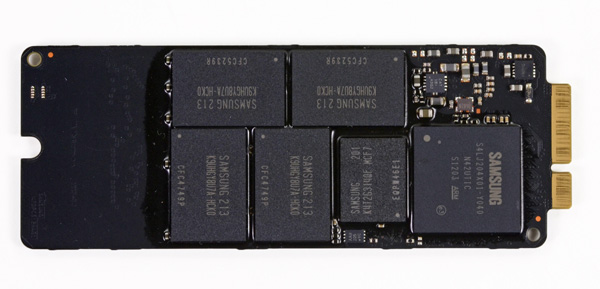
The Samsung PM830 based rMBP NAND flash storage card, image courtesy iFixit
My Retina MacBook Pro was the upgraded model with a 512GB SSD, featuring Samsung’s PM830 controller. This is the same controller as in the Samsung SSD 830, which I’ve long felt was the best pair for Mac users who wanted an SSD upgrade. I’m not sure if other Retina MBPs may come with Toshiba’s SandForce based drive instead. I have one of these drives in house for a review but that’ll have to wait until next week.
Although both the Samsung and Toshiba/SandForce controllers support full disk encryption, neither hardware based encryption is supported by OS X’s FileVault 2. When OS X encrypts your boot volume not all areas are encrypted (such as the recovery partition). While I know SandForce allegedly offers multiple encryption levels across a volume I’ve never seen either controller claim support for partially unencrypted volumes. In this case it looks like for Apple to take advantage of SSD controller based encryption it would need more flexible encryption support on the controller level. If I were an SSD controller vendor I’d be paying close attention to this requirement.
Both the Samsung and Toshiba controllers support 6Gbps SATA - as a result performance is significantly better compared to previous Apple branded SSDs. I borrowed a friend’s 2010 MacBook Pro which happened to have a Toshiba based SSD installed and ran it through our standard Iometer four-corners test suite. This was a well used drive and thus the performance is even worse than last year's MacBook Airs. The improvement in performance is astounding:
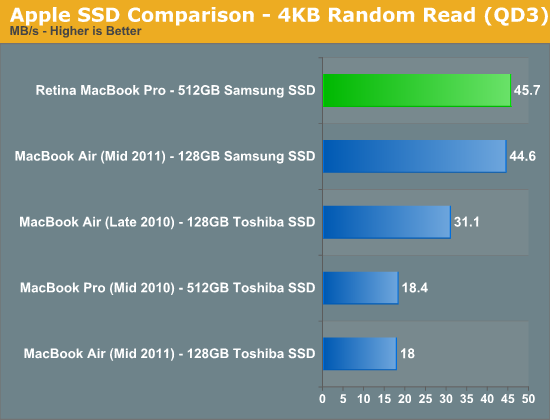
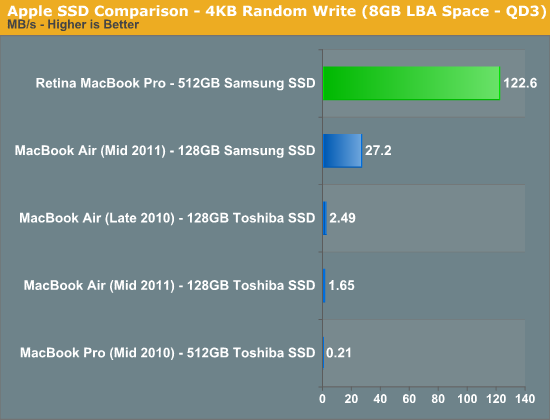
The move to 6Gbps SATA is often associated with a huge bump in sequential transfer rates, but in this case Apple enjoys a significant increase in random speeds as well. Note that some of this improvement is going to be due to the fully populated configuration of the PM830 in the Retina MacBook Pro's SSD, but that shouldn't downplay the significance of the move to Samsung's latest controller. The previous generation controller used last year just wasn't very good, and the Toshiba alternative was even worse. This year, Apple finally has a good solid state story to tell.
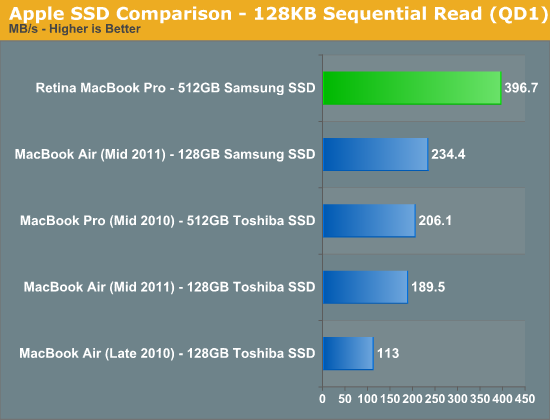
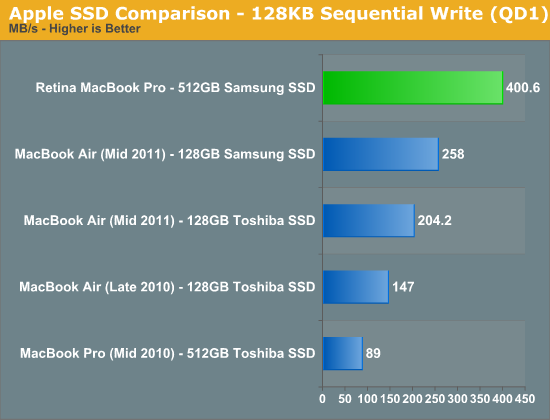
How much of this are you going to be able to actually tell in day to day use of the system? The sequential transfer rates are most tangible when you are writing to or reading large files like movies to your drive. Obviously you need a source that's fast enough to hit these speeds. Although USB 3.0 can come close you're unlikely to have a USB 3.0 SSD that's as fast as the internal drive. Moving large files between your internal SSD and Promise's Pegasus R4/R6 is where you'll really appreciate this performance.
The random access improvements are likely overkill for most normal uses. Things like program launches, compiling, web browsing, and any other normal application IO will depend on a mixture of random and sequential IO. The key is to have good enough random IO performance to avoid becoming a bottleneck. I can safely say that the numbers we see here are more than enough.
While previous Apple SSDs were nice only from a convenience standpoint, at least the Samsung option in the Retina MacBook Pro is what I’d recommend even if Apple didn’t bundle it with the machine.










471 Comments
View All Comments
Super56K - Saturday, June 23, 2012 - link
Maybe talking paper specs on the software side it's 'the same' but really that's not even close. Dpi scaling is flaky in Windows anyways.And it's really not the same. It's rendered at double the resolution on a screen that actually has 4x's the pixels at the native 1440x900 res. Nobody else does that. Hell, it's rare to even find a 16:10 Windows laptop.
I don't own a MacBook anything, but some of you sound ridiculous in here going on about Sony laptops with 1080p screens
Spunjji - Tuesday, June 26, 2012 - link
What if I, the user, don't want my laptop rendering the display at a pointlessly high resolution just to scale it back down again? I understand the theory but the execution is utterly ridiculous.UpSpin - Saturday, June 23, 2012 - link
You're right, it wouldn't sell, because the issue is that Windows DPI scaling doesn't work so well. It also doesn't work perfectly in Mac OS (Chrome best example, they had to update it). And so will many older programs, which don't receive further updates, like Adobe Creative Suite <6 don't scale right (assumption)That's one reason that Apple released only one MacBook with a retina display, because the software isn't ready for DPI scaling yet. Apple was brave enough to do the step and force programers to integrate scaling in high res images in their programs because future MacBooks will have retina displays only.
No PC manuafcturer could have done such a step, they would have been blocked by the lack of proper scaling of Windows, rendering a high res display useless because of display errors. So Microsoft should have made Windows 7 resolution independent (just as all mobile OS are, which rely on DPI instead of absolute pixels), then PC manufacturers could have included high res displays which the customer could have used.
EnzoFX - Saturday, June 23, 2012 - link
MS Should have with Win7? Hardly. That was too long ago and there were no retina screens yet. Even 1080p screens were scarce. Remember that 99% were getting 1366x768 in their laptops.You're right in that Apple can sort of force developers to update apps for support. I do give them credit for usually implementing a solid stopgap. Their scaling for older apps is usually good enough without it being a bad experience. Forcing them to update is a good thing though, having that ecosystem of active developers is good. It's further easier on them to target simple hardware configurations. The benefits of vertical integration at its best. Now for these retina displays to trickle down to all their displays =P.
ananduser - Saturday, June 23, 2012 - link
Win7 scales perfectly well for a screen this res. Such an absurd panel jump however is meant as bragging rights. It also serves as differentiation. Instead of going "post PC" like W8 transformer devices at Computex, it adds a huge panel. There's nothing special about the hardware that hasn't been done before, except the impressive panel.Ohhmaagawd - Saturday, June 23, 2012 - link
Exactly what would constitute "special"?dagamer34 - Sunday, June 24, 2012 - link
Mobile operating systems aren't resolution independent. The iPhone supports 2 resolutions, Windows Phone currently supports 1 resolution, but will support 3 in WP8, and Android supports a variety of resolutions, but is NOT resolution independent.garcondebanane - Saturday, June 23, 2012 - link
Frankly, yes I think so. See "the software side of retina" and "Achieving retina".I don't think any other PC manufacturer can realistically be expected to do it this seamlessly.
UberApfel - Saturday, June 23, 2012 - link
Apple didn't think of the idea. The screens are simply now available and Apple has the resources and reason to push it to market first. Apple also has their own operating system and software engineers to prepare for such.Anyone familiar with the market knows that Microsoft is a big kid nurtured by monopoly and ripping off corporations. The 'big game-changing release & failure' every few years just doesn't allow manufacturers to be first-adopters. Only OSX stays up-to-date, and only Apple may use OSX thanks to either IP or special-order hardware.
If Asus, Acer, or Toshiba were to shell out the cash to get a portion of the first batch and mass-produce some laptops w/ "retina display"; they'd just have a deficit. Apple is a designer; not a innovator. Anyone who makes that mistake is a fool.
MrSpadge - Monday, June 25, 2012 - link
It's not only about thinking about it, it's about building it and reaching out to make people buy it. It's hard to do this without the "Apple hype", no matter how good and innovative the product may be.